
The West Coast Main Line (WCML) is one of the most important railway corridors in the United Kingdom, connecting the major cities of London and Glasgow with branches to Birmingham, Liverpool, Manchester and Edinburgh. It is one of the busiest mixed-traffic railway routes in Europe, carrying a mixture of intercity rail, regional rail, commuter rail and rail freight traffic. The core route of the WCML runs from London to Glasgow for 399 miles (642 km) and was opened from 1837 to 1869. With additional lines deviating to Northampton, Birmingham, Manchester, Liverpool and Edinburgh, this totals a route mileage of 700 miles (1,127 km). The Glasgow–Edinburgh via Carstairs line connects the WCML to Edinburgh. However, the main London–Edinburgh route is the East Coast Main Line. Several sections of the WCML form part of the suburban railway systems in London, Coventry, Birmingham, Liverpool, Manchester and Glasgow, with many more smaller commuter stations, as well as providing links to more rural towns.
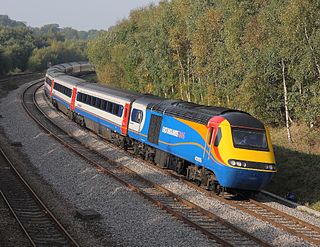
The Midland Main Line is a major railway line in England from London to Sheffield in Yorkshire via the East Midlands. It comprises the lines from London's St Pancras station via Leicester, Derby/Nottingham and Chesterfield.

The East Coast Main Line (ECML) is a 393-mile long (632 km) electrified railway between London and Edinburgh via Peterborough, Doncaster, York, Darlington, Durham and Newcastle. The line is a key transport artery on the eastern side of Great Britain running broadly parallel to the A1 road.

Rugby railway station serves the town of Rugby in Warwickshire, England. The current station dates from 1885; two previous stations dating from 1838 and 1840 respectively, existed at locations to the west of the current one. It has been Rugby's only station, since the closure of the former Rugby Central station in 1969, on the now-abandoned Great Central Main Line route through the town. Between 1950 and 1970, the station was known as Rugby Midland before reverting to its original title. The station underwent an extensive remodelling between 2006 and 2008; new platforms were added and a new ticket office and entrance building were constructed. The original Victorian part of the station was retained in the upgrade.
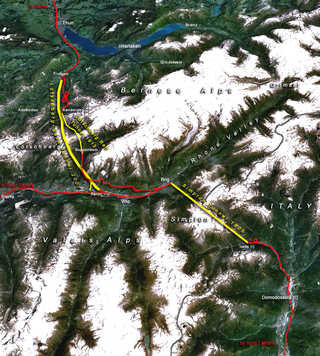
The Lötschberg Base Tunnel (LBT) is a 34.57 km (21.48 mi) railway base tunnel on the BLS AG's Lötschberg line cutting through the Bernese Alps of Switzerland some 400 m (1,300 ft) below the existing Lötschberg Tunnel. It runs between Frutigen, Berne, and Raron, Valais.
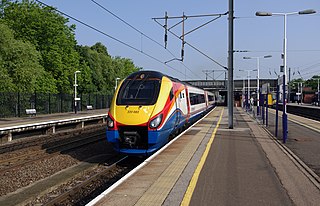
Bedford railway station is the larger of two railway stations in the town of Bedford in Bedfordshire, England. It is on the Midland Main Line from London St Pancras to the East Midlands and the terminus of the Marston Vale line from Bletchley through Bedford St Johns.
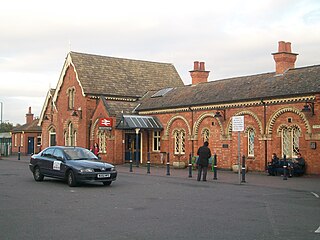
Wellingborough railway station is a Grade II listed station located in the market town of Wellingborough in Northamptonshire, England. It lies on the Midland Main Line and is 65 miles (104 km) from London St. Pancras. The station is operated by East Midlands Railway, which is also the primary operator serving the station with passenger services.

Disley Tunnel was built by the Midland Railway in 1902 on its line between New Mills South Junction and Manchester Central, which was more direct than the congested and difficult lines through Stockport Tiviot Dale.

The Cologne–Frankfurt high-speed rail line is a 180-kilometre-long (110 mi) railway line in Germany, connecting the cities of Cologne and Frankfurt. Its route follows the Bundesautobahn 3 for the greater part, and currently the travel time is about 62 minutes. The line's grades of up to four percent require trains with a high power-to-weight ratio which is currently only met by third-generation Intercity-Express trains. It was constructed between 1995 and 2002 at a total cost of six billion Euro according to Deutsche Bahn.
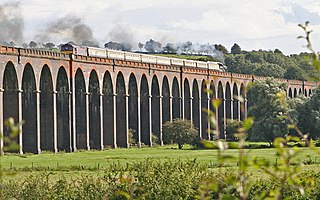
The Oakham–Kettering line is a railway line in the East Midlands of England. Currently it has one passenger station in operation, at Corby.

The Great Central Main Line (GCML), also known as the London Extension of the Manchester, Sheffield and Lincolnshire Railway (MS&LR), is a former railway line in the United Kingdom. The line was opened in 1899 and built by the Great Central Railway running from Sheffield in the North of England, southwards through Nottingham and Leicester to Marylebone in London.

High-speed rail in the United Kingdom is provided on five upgraded railway lines running at top speeds of 125 mph (200 km/h) and one purpose-built high-speed line reaching 186 mph (300 km/h).

Ampthill railway station was built over a mile from the historic market town of Ampthill in the English county of Bedfordshire by the Midland Railway in 1868 on its extension to St. Pancras.

The InterCity 250 was an electric railway project undertaken by British Rail in the late 1980s. The InterCity 250 train would have consisted of a Class 93 electric locomotive, nine Mark 5 coaches and a Mark 5 Driving Van Trailer operating in a push-pull formation. The British Rail project was cancelled in July 1992.

Southampton Tunnel is a 528-yard railway tunnel that runs close to the Civic Centre in the centre of the Hampshire city of Southampton, in England.

The Northampton–Market Harborough line is a closed railway line in England. It opened on 16 February 1859 and finally closed on 16 August 1981. The former trackbed is used by the Brampton Valley Way and part of the route has been re-opened as the Northampton & Lamport Railway.

Stowe Hill Tunnel is a railway tunnel on the West Coast Main Line just south of the village of Weedon, Northamptonshire, England. The tunnel runs in a straight line underneath the A5 main road between Weedon and Towcester from about northwest to southeast. The tunnel has a single bore with twin tracks and is 491 yards (449 m) long. The next station southbound is Wolverton and northbound Rugby. The tunnel was opened in 1838 as a part of the London and Birmingham Railway.

Linslade Tunnel is a railway tunnel in Bedfordshire, England, on the West Coast Main Line about 0.54 miles (0.9 km) north of Leighton Buzzard railway station and built under Linslade Woods. Consisting of three individual bores, the tunnel is somewhat unusual as there is a slight bend in its alignment.

The Canal Tunnels are a pair of single track railway tunnels in north London which connect the East Coast Main Line to London St Pancras International Thameslink. Their name comes from the Regent's Canal, which they pass closely beneath.
The Nottingham direct line of the Midland Railway was a new route created in 1879 to relieve congestion on the established routes of the Midland Railway, in England. It consisted of two connecting lines that, together with part of an existing route, formed a new route from Nottingham to near Kettering. The line was used for Nottingham to London express passenger trains, and for heavy mineral and goods trains heading south. As well as shortening the transit a little, the new line had the effect of relieving congestion on the original main line through Leicester, that had become excessively congested.



















